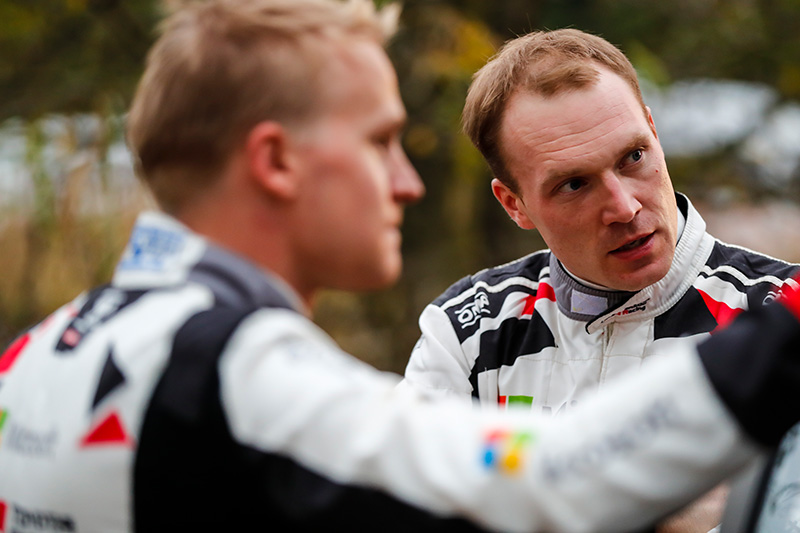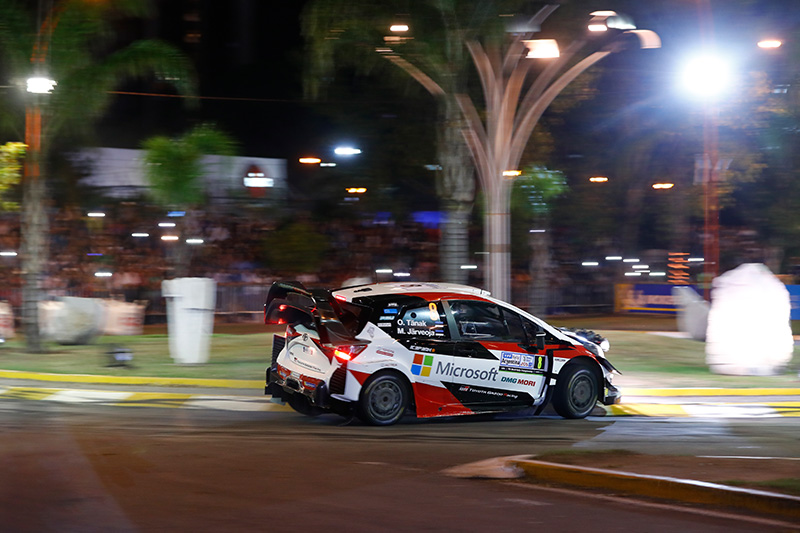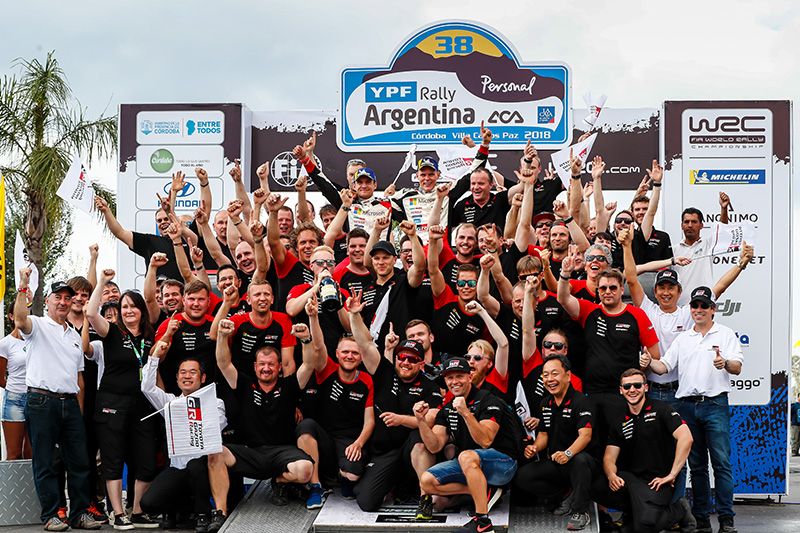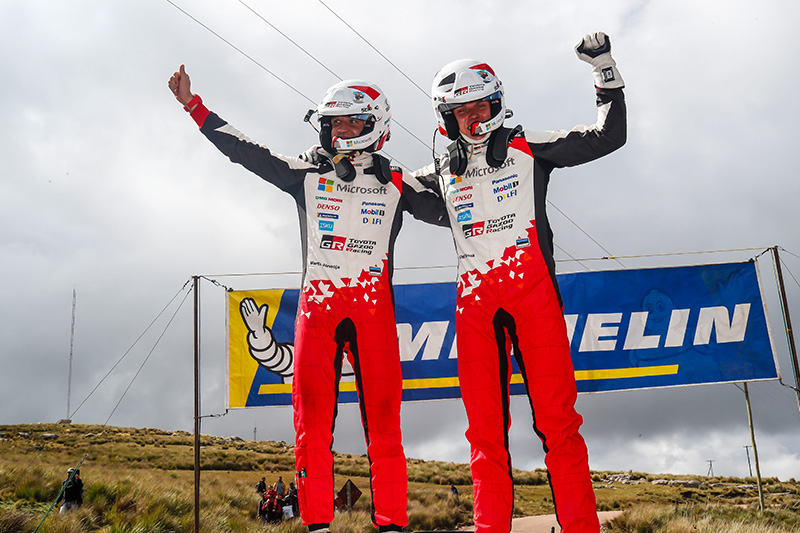RALLY ARGENTINA
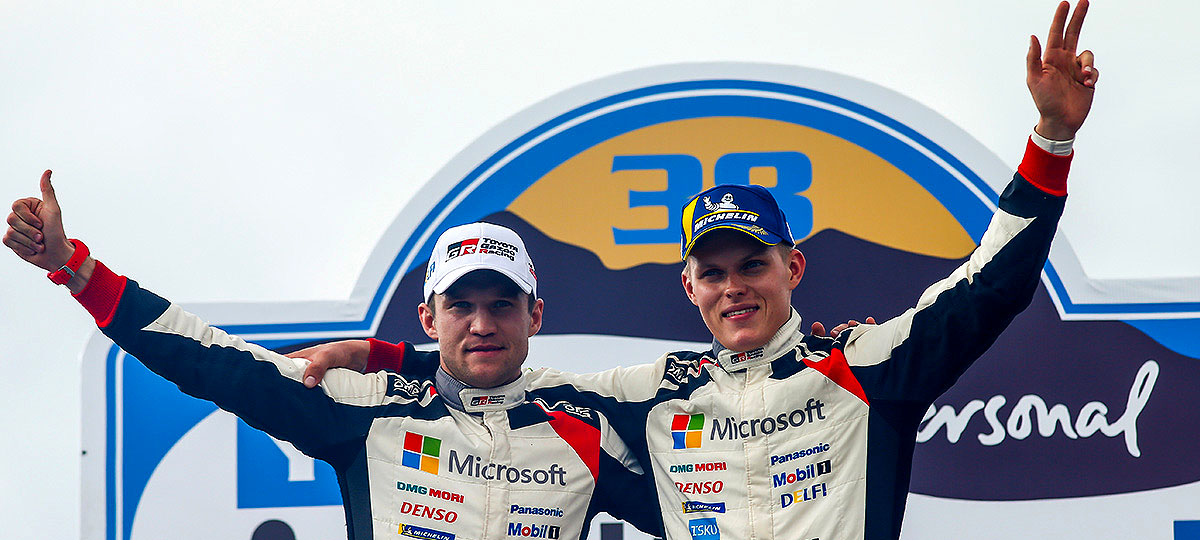
The Yaris WRC exhibits improved endurance and speed on rough roads
Tänak records fastest times in 10 SSs and secures his first overall victory since joining the TOYOTA GAZOO Racing team
2017 marked the first year of Toyota’s WRC comeback, and the Yaris WRC experienced a baptism of fire on the rough gravel of the Rally Argentina. “Rough gravel” refers to dilapidated, unpaved roads, and is the very opposite of the smooth gravel found in the Rally Finland. The TOYOTA GAZOO Racing World Rally Team is based in Finland, and the Yaris WRC has been developed on flat, high-speed, and smooth gravel surfaces. For this reason, the car demonstrates outstanding competitiveness on the successive smooth, high-speed rally stages found at Rally Finland and Rally Sweden, and has twice been victorious at such rallies. On the other hand, at last year’s Rally Argentina, where the roads were rougher than normal, something which rarely happens, the Yaris WRC was forced to endure tough battles. Since its body was designed to be extremely robust, the car held its own on the rough surfaces; however, its bumpers, mainly in the bottom, were destroyed, and the lower portions of the body struck the ground forcefully many times. As a result, there were problems with some of the car’s parts, resulting in decreased engine power.
Ensuring that the lower parts of the body do not hit the ground is not difficult: it is largely a matter of adjusting the dampers and springs and raising the height of the rally car. However, decreasing the height of a car improves both maneuverability and aerodynamics—this is evident from racing cars that compete on circuits, or rally cars that are set up for tarmac.
Increasing the height of a car therefore results in inferior maneuverability; attempts to improve maneuverability while increasing the height of the car require increased spring rates to ensure that the body does not move too much, and the car’s suspension has to be made firmer. However, firming up the suspension causes its own problems—it becomes more difficult for tires to stay in contact rough, unpaved surfaces, and it likewise becomes more difficult for the engine to transmit power to the road surface. In other words, increasing vehicle height leads to reduced traction.
Improved suspension leads to better traction
The TOYOTA GAZOO Racing team sought to increase the height of the vehicle while still ensuring outstanding maneuverability and traction. Based on its experiences in 2017, the team focused on improving the Yaris WRC’s suspension. In particular, the team concentrated on improvements to the car’s dampers, and carried out a succession of development tests in order to gain as much traction as possible. At the pre-rally testing that took place in Sardinia, Italy, just before the start of Rally Argentina, the team was able to verify advancements to its suspension. The drivers and engineers entered the rally confident that the Yaris WRC would perform on rough surfaces: “The car will be able to compete for victory.”
After stumbling in the initial SSs, Tänak recovers to record successive stage victories
The team lined up at the Rally Argentina with great confidence; however, the initial stages did not go according to plan. On April 26, the opening Super Special Stage took place in the city of Villa Carlos Paz, and Ott Tänak recorded the second fastest time. However, the Estonian spun on SS2, the first stage of Day Two, when the rally switched to gravel courses set in more rural surroundings. He lost 20 seconds and suffered minor damage to his steering system.
On SS3, Jari-Matti Latvala, who had been in third position overall after SS2, damaged his front suspension after he struck with his front-right wheel a rock hidden in the grass at a corner exit. His engine’s lubrication system was damaged, and he was forced to abandon the rally.
The Rally Argentina courses were extremely rough in places, with large rocks strewn across the surface. Many areas which had been stone-free during the recce (an abbreviation of “reconnaissance,” where drivers check out the courses before the start of the rally) were covered in rocks that had been churned up by earlier starting rally cars. No matter how cautiously the drivers drove, it was impossible to avoid all the rocks, and different drivers were affected differently even when hitting the same rocks. Latvala’s accident was a case of bad luck. He said: “The car felt perfect. It was a pleasure to drive, and that makes it all the more disappointing.” Just before hitting the rock, Latvala’s intermediate split was comparable to that of Tänak, who would go on to win the stage. “The car was really great. So, I have high expectations for next round’s Rally Portugal.” Latvala was convinced by the Yaris WRC’s performance in rough gravel rallies, and left Rally Argentina in a positive mood.
The outstanding performance of the Yaris WRC makes setup adjustments unnecessary
Tänak implemented emergency measures on the slight damage he suffered on SS2, and subsequently recorded leading times on both SS3 and SS4. Although his car was not in perfect condition, he was able to complete the stages faster than any other driver. Tänak was in first position overall after the morning’s stages, when he returned to the service park. There, team mechanics returned his car to its ideal state in double-quick time. However, they opted not to alter the setup of the vehicle, with the exception of increasing the car height by 5mm—Tänak predicted the course surfaces of afternoon’s repeat SSs would become increasingly rough. The afternoon’s SSs, which were repeats of the morning SS courses, now had deeper ruts and a greater number of exposed stones and rocks. The course conditions had deteriorated significantly, and the drivers were forced to maneuver with greater caution than in the morning. Yet Tänak had absolute confidence in his perfect condition Yaris WRC after it was repaired; and he increased his pace and secured the fastest times on three successive stages. The Estonian defended his position at the top of the overall standings, and ended Day Two with a calm smile: “I attacked aggressively today, and the car responded to my input extremely well. I was able to drive with great confidence.”
Tänak continues to drive with overwhelming speed, and secures his first overall victory since joining Toyota
Tänak maintained his speed on Day Three of the rally, marking the leading times on the first three SSs of the day. Combined with his performances the previous day, this improved his streak of consecutive stage victories to six. The Estonian also posted two further stage wins in the afternoon, thereby extending his lead in the overall standings to 46.5 seconds over second place. Tänak judged this lead to be sufficient and drove more sedately on the final day of the rally. He controlled his performance perfectly and racked up his third rally victory in total—and his first since joining the TOYOTA GAZOO Racing team. Tänak said: “The car performed consistently and felt perfect—in the end, we didn’t change the settings once. On Day Three, I drove cautiously and avoided taking too many risks. But, even then, I surprised myself by recording a number of best times. I am truly grateful to the team who worked together to create such a splendid car, and who provided such great support during the rally.”
The team increased the height of the vehicle so that it would be able to respond to rough roads; as a result, compared to last year there was minimal damage to the front bumper. In addition, despite increasing the height of the vehicle, the Yaris WRC maintained its sharp handling, and it demonstrated outstanding traction throughout the rally. Tänak’s supreme skill enabled him to extract the full potential from the Yaris WRC—he recorded ten stage wins on his way to his first overall victory of the season.
A learning experience for Lappi who, competing in his first-ever Rally Argentina, suffers four punctures
Esapekka Lappi was competing at his first-ever Rally Argentina. Yet even though he suffered a total of four punctures, he still managed to finish in eighth position overall. Lappi is similar to Tänak in that he drives in an extremely precise manner; however, due to minute differences both in the way he operated the car and in the lines he took, he suffered multiple punctures. Although the Finn’s first-ever Rally Argentina turned out to be a stressful ordeal, he showed strong pace, recording second-place finishes in some stages. Not being disappointed, Lappi embraced his Rally Argentina experience and set his mind on developing further: “It is important for me to analyze why I punctured so many times, and to ensure that I am better prepared for the next rally.”
This season, the TOYOTA GAZOO Rally team’s goal is for all its drivers to compete for podium places at every single rally. Rally de Portugal, round 6, is also a gravel rally, and is comparatively similar to Rally Argentina. The team will therefore aim to maintain its outstanding form and realize even loftier ambitions.
RESULT
| Pos | Driver | Co-Driver | Vehicle | Time |
|---|---|---|---|---|
| 1 | Ott Tänak | Martin Järveoja | Toyota Yaris WRC | 3h43m28.9s |
| 2 | Thierry Neuville | Nicolas Gilsoul | Hyundai i20 Coupe WRC | +37.7s |
| 3 | Dani Sordo | Carlos Del Barrio | Hyundai i20 Coupe WRC | +1m15.7s |
| 4 | Sebastien Ogier | Julien Ingrassia | Ford Fiesta WRC | +1m58.6s |
| 5 | Andreas Mikkelsen | Anders Jaeger | Hyundai i20 Coupe WRC | +2m02.6s |
| 6 | Elfyn Evans | Daniel Barritt | Ford Fiesta WRC | +3m06.3s |
| 7 | Kris Meeke | Paul Nagle | Citroen C3 WRC | +3m25.7s |
| 8 | Esapekka Lappi | Janne Ferm | Toyota Yaris WRC | +4m32.6s |
| 9 | Teemu Suninen | Mikko Markkula | Ford Fiesta WRC | +5m38.6s |
| 10 | Pontus Tidemand | Jonas Andersson | Skoda Fabia R5 | +12m15.8s |
| Retired | after day 2 Jari-Matti Latvala | Miikka Anttila | Toyota Yaris WRC |



